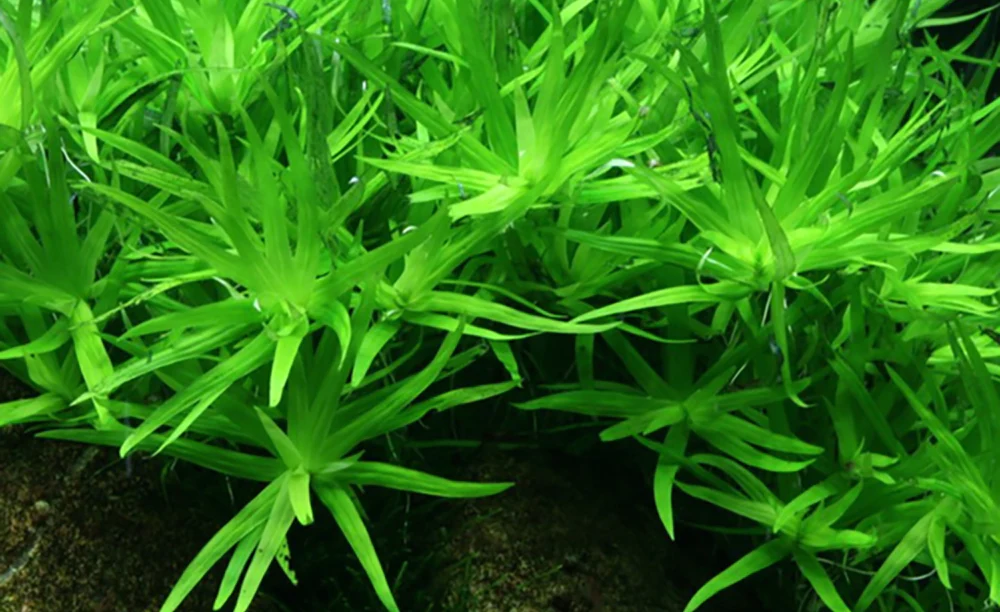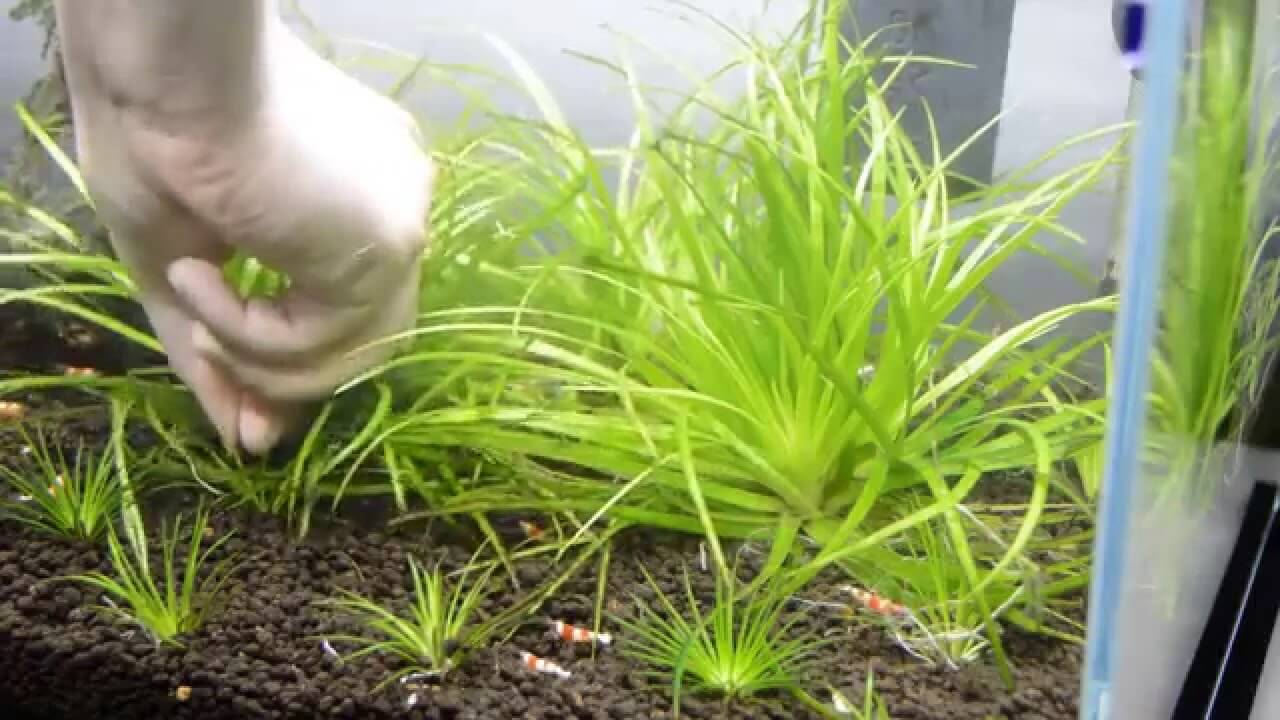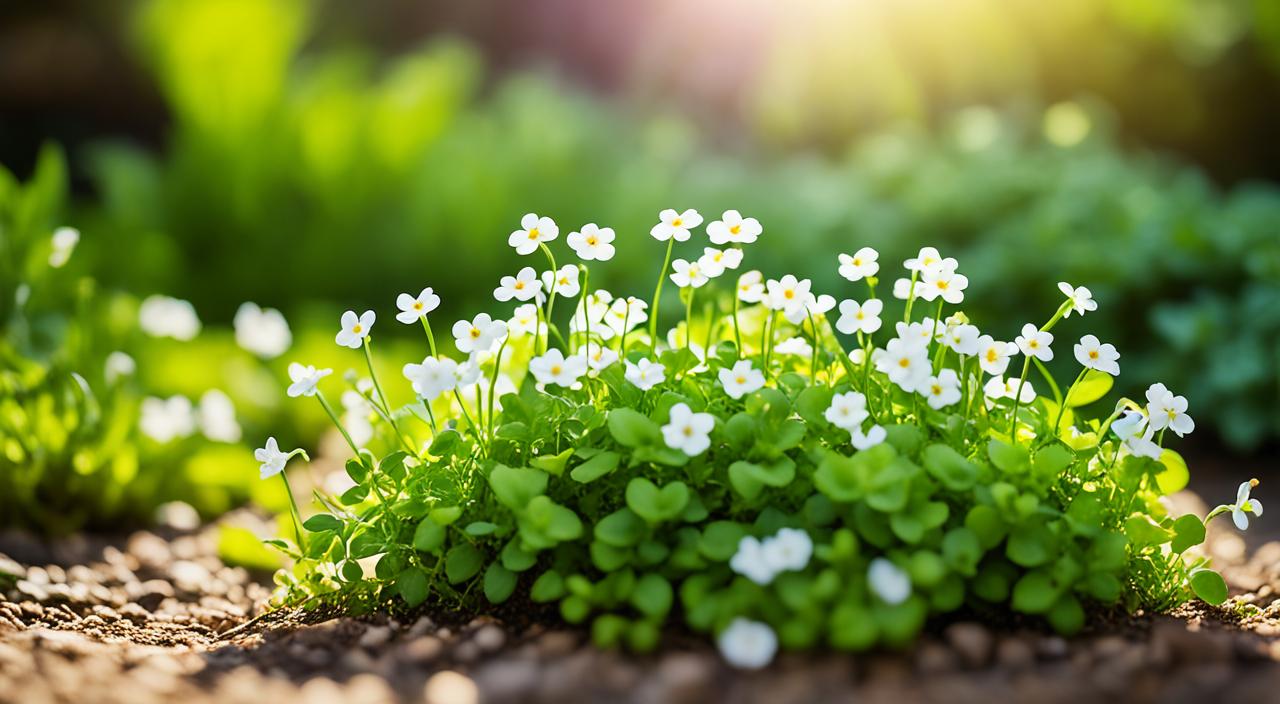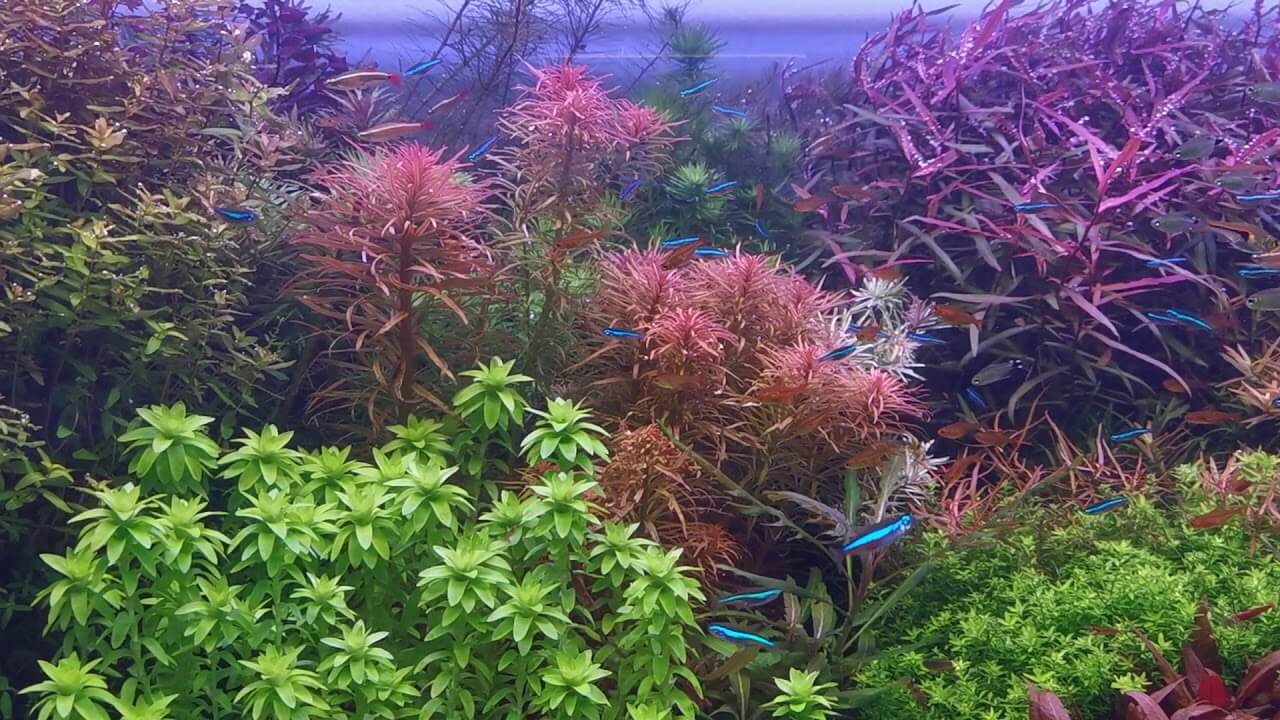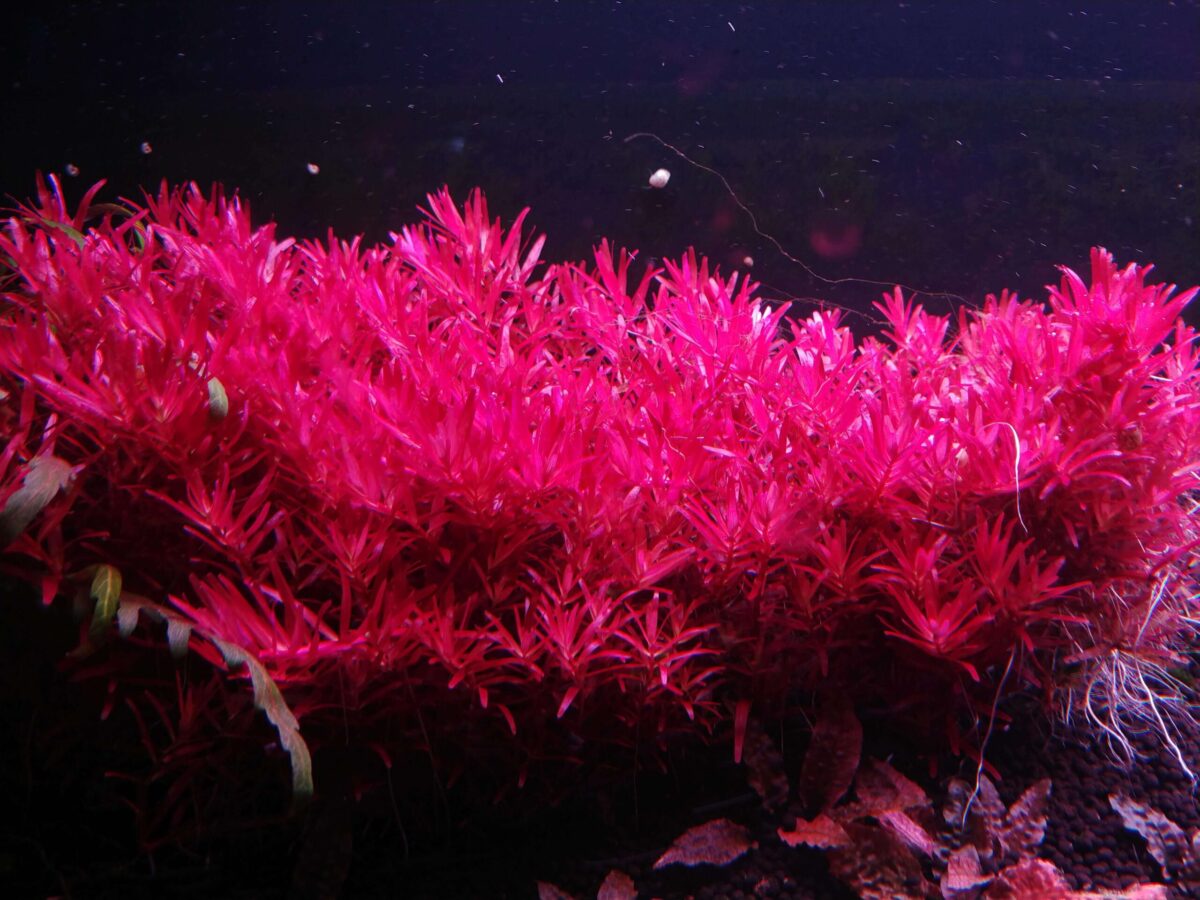Greetings aquarists! In this article, I will share valuable information on caring for Cardamine Lyrata, a stunning freshwater aquarium plant. Whether you’re a beginner or an experienced hobbyist, this guide will provide you with the essential knowledge to ensure the health and vibrancy of your aquatic plant.
Key Takeaways:
- Cardamine Lyrata is a popular freshwater aquarium plant that adds beauty to any tank.
- It thrives in medium to high lighting conditions and prefers lower temperatures.
- While CO2 injection is unnecessary, it can enhance the growth of Cardamine Lyrata.
- Ensure suitable tank mates, proper feeding and fertilization, and regular maintenance.
- Monitor for signs of good health and promptly address any health issues or plant pests.
Brief Overview of Cardomin lyrata
Cardomin lyrata, scientifically known as Cardamine lyrata, is an undemanding and fast-growing stem plant. It features trailing stems with light green, kidney-shaped leaves. This plant thrives in medium to high lighting conditions and does not require CO2 injection, although it benefits from it. It prefers lower temperatures and has an optimal temperature range of 15-28°C. Cardomin lyrata is an easy-care plant with a moderate growth rate, making it suitable for beginners and experienced aquarists.
Cardamine lyrata Information Table:
| Attribute | Description |
|---|---|
| 1. Scientific Name: | Cardamine lyrata |
| 2. Common Names: | Japanese Cress, Lyrata |
| 3. Origin: | Asia |
| 4. Height: | Up to 30 cm (12 inches) |
| 5. Growth Rate: | Medium |
| 6. Colour: | Light green |
| 7. Aquarium Placement: | Background or mid-ground, depending on tank size |
| 8. Water Type: | Freshwater |
| 9. pH: | 5.0 – 7.5 |
| 10. Care Level: | Easy to moderate |
| 11. Light Requirements: | High; 50-70 PAR (Photosynthetically Active Radiation), 5000-7000 Kelvin, 40-60 LUX for optimal growth |
| 12. CO2 Requirements: | Beneficial but not mandatory; 6-14 mg/L for optimal growth |
| 13. Temperature: | 18°C – 26°C (64°F – 79°F) |
| 14. Flow Rate: | Moderate to high |
| 15. Propagation: | Stem cuttings |
| 16. Feed Type: | Liquid fertilizers and CO2 supplementation recommended |
Expanded Light Requirements:
For Cardamine lyrata, achieving lush growth and vibrant health requires specific lighting conditions. The plant thrives under high light intensity, with a PAR (Photosynthetically Active Radiation) value of 50-70, crucial for photosynthesis. A 5000-7000 Kelvin light spectrum is ideal, mimicking the natural sunlight conditions and promoting healthy growth. This Kelvin range enhances the natural green colouration of the leaves and supports overall plant health. Additionally, maintaining a LUX level of 40-60 ensures that the plant receives enough light without being exposed to excessive intensity that could cause stress or bleaching. Proper lighting supports growth and enhances the plant’s aesthetic appeal in the aquarium.
Origins and Habitat
Cardamin lyrata is a freshwater aquatic plant commonly used in aquascaping due to its attractive appearance and ease of care. While the specific origins of Cardamin lyrata are not specified in the sources, it is native to certain regions, thriving in freshwater environments such as ponds, streams, and marshes.
Aquascaping is the art of creating visually pleasing and healthy aquarium setups, replicating the natural habitat of aquatic plants and creating stunning underwater landscapes. By incorporating Cardamin lyrata into your aquascape, you can enhance the beauty of your aquarium while providing a suitable environment for this aquatic plant to thrive.
Creating an aquascape that mimics the natural habitat of Cardamin lyrata involves carefully selecting suitable substrates, rocks, and driftwood. By considering this plant’s lighting requirements, water parameters, and placement preferences, you can create a visually appealing and biologically balanced underwater ecosystem.
Next, we will explore the morphological characteristics of Cardamin lyrata, shedding light on its unique traits and physical appearance.
Morphological Characteristics
Cardamin lyrata is characterized by trailing stems that bear light green, kidney-shaped leaves. The leaves are typically light green, but they may vary depending on the lighting conditions and other factors. This plant has a bushy growth habit and can grow to a moderate height. It is considered a high-light aquatic plant, requiring medium to high lighting levels to support its growth and overall health.
Placement and Lighting
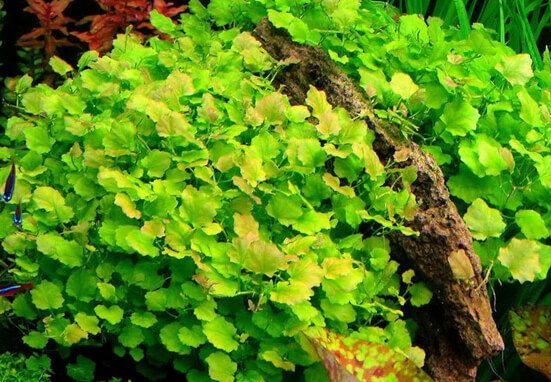
When placing Cardamin lyrata in your aquarium, it is important to consider its lighting requirements. This plant thrives in medium to high-lighting conditions, so ensure your aquarium has adequate lighting to support its growth. Additionally, Cardamin lyrata is best suited for the mid-ground or carpet placement in your tank. It can be planted directly in the substrate or attached to rocks or driftwood. Regarding water quality, it is important to maintain suitable parameters such as pH, hardness, and temperature. Proper filtration and water flow are also essential for the health and well-being of Cardamin lyrata.
What Are Good Tank Mates?
Cardamin lyrata, or Cardomin lyrata, is compatible with various fish and invertebrate species in the aquarium. When choosing tank mates for this plant, it is essential to consider their behaviour and potential impact on the delicate leaves of Cardamin lyrata. The following is a list of good tank mates that can coexist harmoniously with this plant:
Good Tank Mates
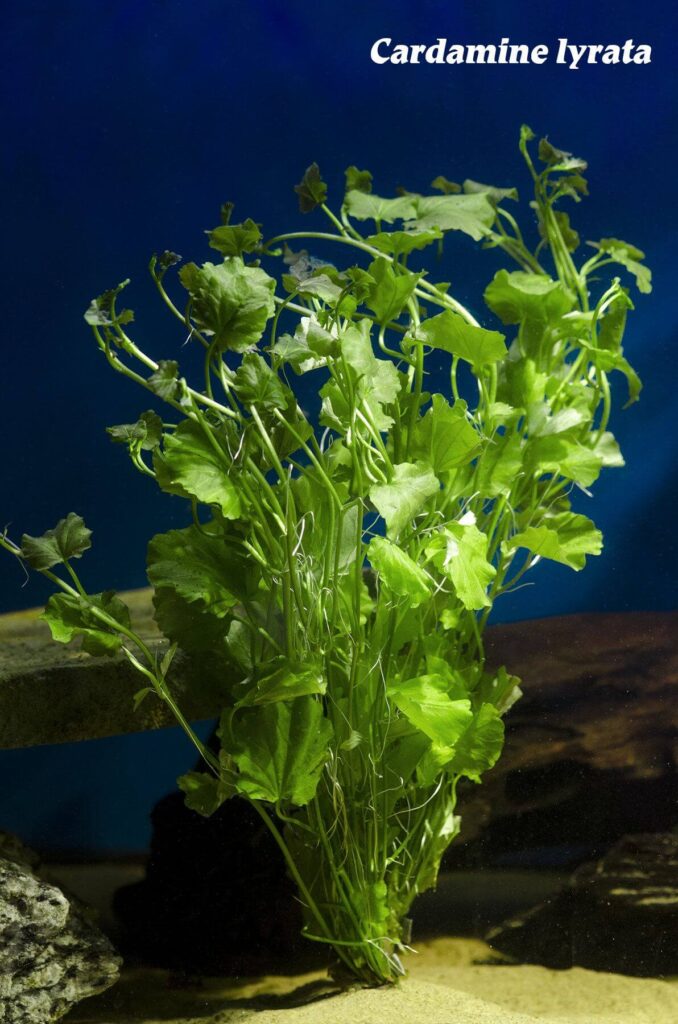
- Tetras
- Rasboras
- Guppies
- Small Catfish
These peaceful community fish species tend to be non-aggressive and are less likely to uproot or damage the leaves of Cardamin lyrata. They also provide a visually appealing and diverse aquarium environment.
Fish Species To Avoid
When it comes to choosing fish species to avoid, it is recommended to steer clear of more extensive, aggressive fish that may pose a threat to the well-being of Cardamin lyrata. Additionally, herbivorous fish species should be cautiously approached to prevent them from feeding on the plant. By avoiding the following fish species, you can ensure the health and vitality of both the plant and the other aquatic animals in your aquarium:
- Enormous, aggressive fish species
- Herbivorous fish species
Choosing compatible tank mates is crucial for maintaining a balanced and peaceful aquatic environment where Cardamin lyrata can thrive.
Feeding (Fertilization)
Proper feeding and fertilization are essential for the growth and health of Cardamin lyrata. While this plant can obtain most nutrient requirements from the water column, supplementing with liquid or substrate fertilizers can promote faster and more robust growth. It is essential to follow the instructions provided with the fertilizers and feed Cardamin lyrata accordingly. Regularly monitoring nutrient levels and adjusting the feeding regimen accordingly is essential to prevent nutrient imbalances and ensure optimal plant health.
As an aquatic plant, Cardamin lyrata requires specific nutrients to thrive. By providing the necessary fertilizers, you can ensure that the plant gets the required nutrition for its growth and development. Generally, a well-balanced liquid or substrate fertilizer formulated for aquatic plants is recommended for Cardamin lyrata. These fertilizers typically contain essential macro and micronutrients needed for robust growth.
When fertilizing Cardamin lyrata, it is essential to consider the plant’s specific needs. Follow the dosage recommendations provided by the manufacturer and adjust the amount based on the size of your aquarium and the plant’s nutrient requirements. It is generally recommended to start with lower doses and gradually increase as needed while monitoring plant growth and nutrient levels. Regular testing of the water parameters, such as nitrate and phosphate levels, can provide valuable insights into the plant’s nutrient needs.
In addition to fertilizers, it is also essential to maintain water quality and perform regular water changes to remove excess nutrients and prevent the buildup of toxins. By ensuring a clean and stable environment, you can support the overall health and vitality of Cardamin lyrata.
Proper feeding and fertilization are critical components of successful aquatic plant propagation. You can promote healthy growth and reproduction by providing the necessary nutrients, allowing Cardamin lyrata to flourish in your aquarium. Regular monitoring and adjustment of the feeding regimen will help you maintain optimal plant development and propagation conditions.
CO2 Injection
While Cardamin lyrata does not require CO2 injection, supplementing with CO2 can promote faster and more robust growth. Various types of CO2 injection systems are available for aquariums, including pressurized CO2 systems, DIY yeast CO2 systems, and liquid CO2 additives. The specific type of CO2 injection system chosen should be based on the aquarium size, the desired level of CO2 supplementation, and personal preferences. It is essential to carefully follow the instructions for the chosen CO2 injection method to ensure safe and effective use.
Care

Providing proper care is essential for the overall health and well-being of Cardamin lyrata. In a planted tank, it is necessary to maintain suitable parameters such as lighting, substrate, water quality, filtration, and water flow.
Planted Tank Parameters
Cardamin lyrata thrives in medium to high lighting conditions, so ensure your aquarium lighting meets these requirements. Adequate lighting promotes photosynthesis and helps the plant grow and develop properly. Consider using LED lights explicitly designed for aquatic plants to provide optimal lighting.
Water Quality
Maintaining proper water quality is crucial for the health of Cardamin lyrata. It is recommended to regularly test and monitor parameters such as pH, temperature, and hardness. This plant prefers slightly acidic to neutral pH levels (6.0-7.0) and water temperature in the range of 72°F to 82°F (22°C to 28°C).
Filtration
Effective filtration is essential for removing impurities and maintaining water clarity. Use a quality aquarium filter that provides mechanical, chemical, and biological filtration to keep the water clean and free from debris and harmful substances. Regular maintenance and cleaning of the filter are essential to ensure its proper functioning.
Flow
Proper water flow is necessary to prevent the buildup of stagnant areas and ensure the distribution of nutrients throughout the tank. Consider placing the Cardamin lyrata in an area with gentle to moderate water flow. Avoid strong currents as they may cause damage to the delicate leaves and roots of the plant.
| Parameter | Ideal Range | Optimal Range |
|---|---|---|
| Lighting | Medium to high | High |
| pH | 6.0-7.0 | 6.5-7.0 |
| Temperature | 72°F to 82°F (22°C to 28°C) | 75°F to 80°F (24°C to 27°C) |
| Water Flow | Gentle to moderate | Moderate |
In addition to maintaining these parameters, regular observation of Cardamin lyrata is essential to identify any signs of distress or nutrient deficiencies. Adjust the care routine to ensure the plant’s continued health and growth.
Aquarium Maintenance
Regular aquarium maintenance is vital to ensure the well-being of both Cardamin lyrata and the overall ecosystem. This includes testing water conditions regularly to monitor parameters such as pH, temperature, and nutrient levels. Set up your aquarium tank according to the needs of Cardamin lyrata, including appropriate substrate, lighting, and placement. Additionally, learn about propagation methods for Cardamin lyrata to expand your plant population and maintain a healthy and thriving aquarium.
Health and Disease
Keeping an eye on the health of Cardamin lyrata is crucial for its longevity and growth. It is essential to understand the signs of good health and common issues that may arise. By promptly addressing any health concerns and providing appropriate treatment, you can ensure the well-being of Cardamin lyrata in your aquarium.
Signs of Good Health
When Cardamin lyrata is in good health, you will observe vibrant green leaves, indicating proper photosynthesis and nutrient uptake. The plant will exhibit robust growth, with new leaves emerging regularly. Active root systems are another positive sign, as they facilitate nutrient absorption and overall plant stability.
Signs of Poor Health
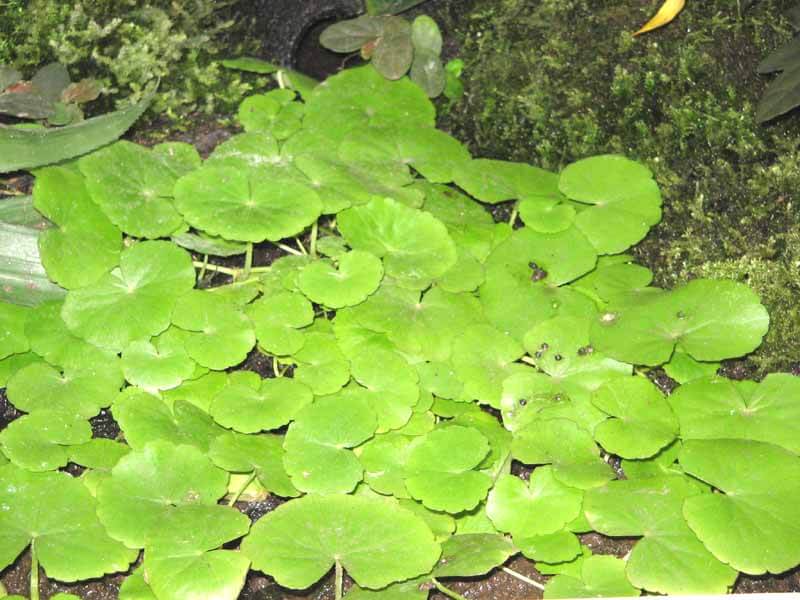
If Cardamin lyrata is not in optimal health, you may notice signs such as yellowing leaves, indicating nutrient deficiencies or other issues. Stunted growth or wilting can also be signs of poor health, highlighting underlying problems that must be addressed.
Common Health Issues and Treatment
Cardamin lyrata may encounter various health issues, including nutrient deficiencies, algae outbreaks, oxygen deficiencies, and infections. Nutrient deficiencies can be addressed by adjusting fertilization and ensuring a balanced nutrient profile. Algae outbreaks can be controlled through proper tank maintenance and lighting adjustments. Oxygen deficiencies can be mitigated by improving water circulation and aeration. Infections may require targeted treatments, such as antifungal or antibacterial medications, to restore the plant to good health.
Plant Pests
While Cardamin lyrata is generally resilient, it may become susceptible to common plant pests such as snails or algae infestations. Regularly inspect and clean your aquarium to prevent pest populations from escalating. Consider introducing natural predators or utilizing appropriate pest control methods to maintain a healthy environment for Cardamin lyrata.
Summary
Cardamin lyrata, also known as Cardomin lyrata, is a versatile and attractive freshwater aquarium plant. It is an undemanding plant that can thrive in medium to high-lighting conditions. While it doesn’t require CO2 injection, supplementing with CO2 can promote faster growth.
Proper care is crucial for the health and well-being of Cardamin lyrata.
First, it is essential to choose suitable tank mates to ensure the plant’s well-being and growth. Peaceful community fish such as tetras, rasboras, guppies, and small catfish are good options. However, avoid larger, aggressive fish species that may damage the delicate leaves of Cardamin lyrata. Herbivorous fish that may feed on the plant should also be avoided.
Feeding and fertilization are essential aspects of Cardamin lyrata care. While this plant can obtain most nutrients from the water column, supplementing it with liquid or substrate fertilizers can promote faster and more robust growth. Regularly monitoring nutrient levels and adjusting the feeding regimen is vital to prevent nutrient imbalances and ensure optimal plant health.
Maintaining proper tank conditions is crucial for the overall health of Cardamin lyrata. This includes maintaining suitable lighting, substrate, water quality, filtration, and water flow. Medium to high lighting is preferred for this plant, while a nutrient-rich substrate or fertilizers can provide necessary nutrients. Additionally, ensuring proper water quality, filtration, and water flow helps maintain optimal plant health and growth conditions.
Regular monitoring, prompt treatment of any health issues, and proactive measures against plant pests are necessary to ensure that Cardamin lyrata thrives in your aquarium.
FAQ
What are the care requirements for Cardamine lyrata?
Cardamine lyrata is an undemanding and fast-growing stem plant that thrives in medium to high lighting conditions. It does not require CO2 injection, although it benefits from it. It prefers lower temperatures and has an optimal temperature range of 15-28°C.
What are the suitable tank mates for Cardamine lyrata?
Good tank mates for Cardamine lyrata include peaceful community fish such as tetras, rasboras, guppies, and small catfish. It is important to avoid keeping larger, aggressive fish species that may uproot or damage the delicate plant leaves. Herbivorous fish species that may feed on the plant should also be avoided.
How often should I feed and fertilize Cardamine lyrata?
Cardamine lyrata can obtain most of its nutrient requirements from the water column, but supplementing with liquid or substrate fertilizers can promote faster and more robust growth. It is recommended to follow the instructions provided with the fertilizers and feed Cardamine lyrata accordingly. Regular monitoring of nutrient levels and adjusting the feeding regimen accordingly is important to prevent nutrient imbalances and ensure optimal plant health.
Does Cardamine lyrata require CO2 injection?
While Cardamine lyrata does not require CO2 injection for its growth, supplementing with CO2 can promote faster and more robust growth. There are various types of CO2 injection systems available for aquariums, and the specific type chosen should be based on the size of the aquarium, desired CO2 level, and personal preferences.
What are the care parameters for a planted tank with Cardamine lyrata?
Proper care parameters for a planted tank with Cardamine lyrata include suitable lighting conditions (medium to high), a nutrient-rich substrate or supplementing with fertilizers, maintaining proper water quality (pH, hardness), filtration, and water flow. These factors contribute to the overall health and well-being of Cardamine lyrata.
How do I maintain my aquarium with Cardamine lyrata?
Regular aquarium maintenance is important for the well-being of Cardamine lyrata. This includes testing water conditions regularly, setting up the aquarium tank according to the plant’s needs, and learning about propagation methods for Cardamine lyrata to maintain a healthy and thriving aquarium.
What are the signs of good health and poor health in Cardamine lyrata?
Signs of good health in Cardamine lyrata include vibrant, green leaves, robust growth, and active root systems. Signs of poor health may include yellowing leaves, stunted growth, or wilting. Common health issues that may affect Cardamine lyrata include nutrient deficiencies, algae outbreaks, oxygen deficiencies, and infections.
What are the best plants for nano tanks?
Cardamine lyrata is considered one of the best plants for nano tanks due to its undemanding care requirements and attractive appearance. Other low maintenance aquarium plants suitable for nano tanks include java moss, anubias nana, and marimo moss balls.
How do I propagate Cardamine lyrata?
Cardamine lyrata can be propagated through stem cuttings. Simply trim a healthy stem and replant it in the substrate or attach it to rocks or driftwood. Over time, the stem cutting will develop roots and grow into a new plant.
What are the optimal pH requirements for Cardamine lyrata?
Cardamine lyrata prefers slightly acidic to neutral water with a pH range of 6.5-7.5. It is important to regularly test and monitor the pH levels in the aquarium to ensure they remain within the optimal range for the plant’s health.

